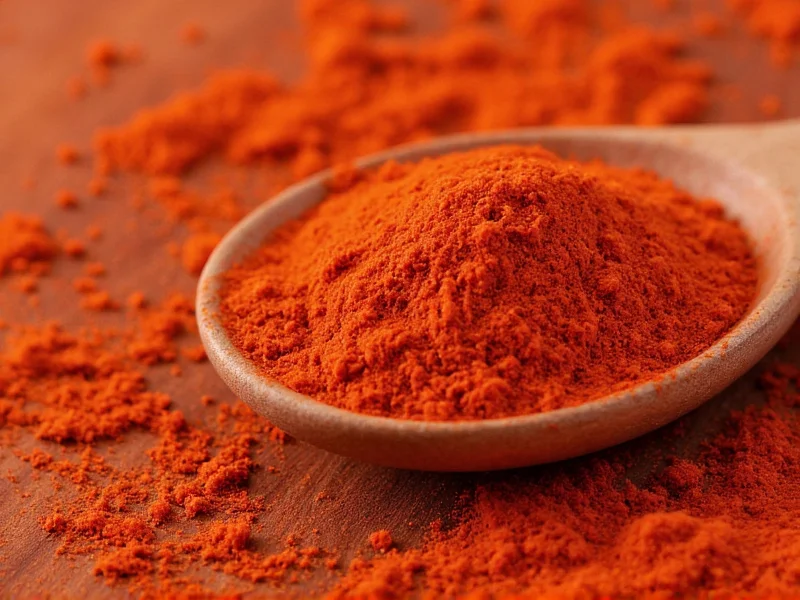When deciding between cayenne or paprika for your cooking, understanding their fundamental differences is essential for achieving the desired flavor profile. These two red spices often confuse home cooks due to their similar appearance, but they serve distinctly different culinary purposes. Knowing when to reach for each spice can transform your dishes from ordinary to extraordinary.
What Exactly Is Cayenne Pepper?
Cayenne pepper comes from specific varieties of Capsicum annuum chili peppers that originated in French Guiana but now grow worldwide. Processed into a fine, bright red powder, cayenne delivers consistent, significant heat that registers between 30,000-50,000 Scoville Heat Units (SHU). Unlike some chili powders that vary in heat, cayenne maintains reliable spiciness because it's made from specific pepper varieties rather than random chili blends.
Culinary professionals value cayenne for its clean, sharp heat that doesn't overpower other flavors when used judiciously. It contains capsaicin, the compound responsible for chili heat, which also offers potential metabolic benefits. When handling cayenne, exercise caution as its fine particles can irritate eyes and skin.
Understanding Paprika's Versatile Profile
Paprika encompasses a broader category of spice made from ground peppers, primarily Capsicum annuum varieties. Unlike cayenne's singular profile, paprika ranges dramatically based on origin and processing:
- Sweet paprika (Hungarian): Mild, slightly sweet with earthy notes (0-500 SHU)
- Smoked paprika (Spanish Pimentón): Rich, smoky flavor from peppers dried over oak fires
- Hot paprika: Contains spicier pepper varieties for noticeable heat (500-1,000 SHU)
The quality of paprika depends heavily on the pepper varieties used and processing methods. Premium paprikas like Hungarian édesnömör or Spanish Pimentón de la Vera undergo careful selection and traditional preparation that preserves flavor compounds lost in mass-produced versions.
Key Differences at a Glance
| Characteristic | Cayenne Pepper | Paprika |
|---|---|---|
| Heat Level (SHU) | 30,000-50,000 | Sweet: 0-500 Hot: 500-1,000 Smoked: Varies |
| Flavor Profile | Sharp, intense heat with subtle fruitiness | Sweet: Earthy, slightly sweet Smoked: Deep, woody notes Hot: Mild heat with pepper flavor |
| Color Contribution | Bright red (may fade with cooking) | Vibrant red that holds color better |
| Primary Culinary Uses | Adding heat to sauces, rubs, and spice blends | Coloring dishes, adding subtle flavor (goulash, deviled eggs, paella) |
| Substitution Ratio | 1/4 tsp cayenne ≈ 1 tsp hot paprika | 1 tbsp paprika ≈ 1/8 tsp cayenne |
When to Choose Cayenne Over Paprika
Select cayenne pepper when your recipe specifically requires significant heat without dramatically altering the dish's color or adding smoky elements. It excels in:
- Creole and Cajun seasoning blends where pronounced heat is essential
- Tomato-based sauces that need heat without additional flavor complexity
- Marinades for meats where deep red color isn't critical
- Health-conscious recipes leveraging capsaicin's potential metabolic benefits
Chefs often prefer cayenne in applications where pure heat is the goal, such as in hot sauces or when building layered spice profiles where other elements provide flavor complexity.
Optimal Uses for Paprika
Paprika shines when you need color enhancement with subtle flavor contributions. Different varieties serve specific purposes:
- Sweet paprika enhances traditional Hungarian goulash and gives deviled eggs their characteristic color without adding heat
- Smoked paprika (Pimentón) transforms paella, roasted vegetables, and bean dishes with its distinctive campfire aroma
- Hot paprika provides gentle warmth to Spanish chorizo and other cured meats
Professional kitchens often layer multiple paprika varieties to create complex flavor profiles. For instance, combining sweet and smoked paprika in barbecue rubs creates depth that cayenne alone cannot achieve.
Substituting Between Cayenne and Paprika
Understanding cayenne or paprika substitution ratios prevents culinary disasters. When substituting:
- To replace cayenne with paprika: Use 1 tablespoon of hot paprika for every 1/8 teaspoon of cayenne
- To replace paprika with cayenne: Start with 1/8 teaspoon cayenne for every 1 tablespoon of paprika, adjusting carefully
- For smoked paprika substitution: No direct cayenne equivalent exists—consider adding liquid smoke sparingly
Always add heat gradually when substituting. It's easier to increase spiciness than to correct an overly hot dish. Remember that cayenne's heat develops more slowly than fresh chilies but lasts longer in cooked dishes.
Storage and Freshness Considerations
Both spices lose potency over time but require different storage approaches. Cayenne's fine texture makes it more susceptible to moisture, while paprika's larger particle size affects its shelf life differently.
Store both in airtight containers away from light and heat. Properly stored cayenne maintains potency for 1-2 years, while paprika typically lasts 1-1.5 years. Check freshness by rubbing a small amount between fingers—if the aroma is weak or musty, replace the spice. Never store either spice above the stove where heat accelerates degradation.
Nutritional Differences Worth Noting
While both spices come from chili peppers, their nutritional profiles differ due to processing and pepper varieties used. Cayenne contains significantly more capsaicin, which research suggests may temporarily boost metabolism and provide anti-inflammatory benefits.
Paprika, particularly sweet varieties, contains higher concentrations of carotenoids like capsanthin that give it vibrant color and function as antioxidants. Smoked paprika offers additional compounds from the smoking process that may provide unique health properties. Neither spice contributes significant calories, but their bioactive compounds make them valuable functional ingredients beyond flavor.
Making the Right Choice for Your Dish
The decision between cayenne or paprika ultimately depends on your recipe's requirements. Ask yourself:
- Do I need significant heat or just color enhancement?
- Would smoky notes complement this dish?
- Is this a traditional recipe where authenticity matters?
- How will other ingredients interact with the spice's flavor profile?
When in doubt, start with less spice—you can always add more. Professional chefs often taste dishes at multiple stages of cooking to adjust spice levels appropriately as flavors develop and concentrate.











 浙公网安备
33010002000092号
浙公网安备
33010002000092号 浙B2-20120091-4
浙B2-20120091-4